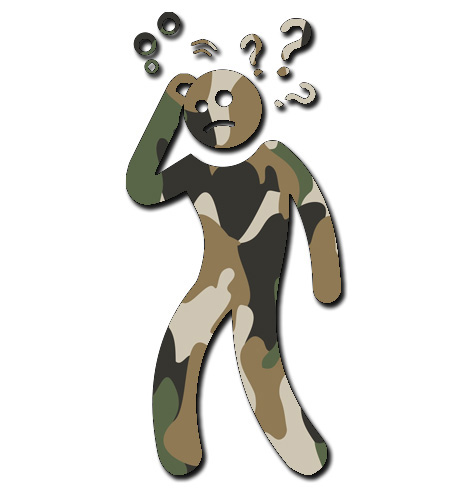Considerations for Disabled Veterans
DSM-5 Diagnostic Criteria
Welcome to our resource page dedicated to helping disabled veterans navigate the DSM-5 diagnostic criteria for PTSD, offering insights, support, and practical guidance tailored to the unique experiences of those who have served.
Post-Traumatic Stress Disorder (PTSD)
The DSM-5 criteria for Post-Traumatic Stress Disorder (PTSD) are as follows:
Criterion A:
Exposure to a Traumatic Event
A person has encountered actual or threatened death, serious injury, or sexual violence through direct experience, witnessing the event, learning about it happening to a close family member or friend, or repeated exposure to distressing details of the traumatic event(s).
Criterion B:
Intrusive Symptoms
A person has distressing memories, recurrent distressing dreams, dissociative reactions (like flashbacks), heightened distress or physiological reactions to cues resembling the event(s), and marked physiological responses to cues symbolizing aspects of the event(s).
Criterion C:
Avoidance
A person makes efforts to avoid external reminders that might trigger distressing
- Memories,
-Thoughts, or
-Feelings associated with traumatic event(s).
Criterion D:
Negative Alterations in Cognitions and Mood
Difficulty recalling key details, overly negative beliefs, distorted thoughts about the event, lasting negative emotions, reduced interest in activities, feelings of detachment from others, and an ongoing struggle to experience positive emotions.
Criterion E:
Alterations in Arousal and Reactivity
Marked alterations in arousal and reactivity that began or worsened after the traumatic event(s), such as irritability or angry outbursts, reckless or self-destructive behavior, hypervigilance, exaggerated startle response, problems with concentration, and/or sleep disturbances.
Criterion F:
Duration of Symptoms
The disturbance persists for a duration exceeding one month, underscoring the lasting impact of the traumatic experience on the individual's mental well-being.
This prolonged duration is a crucial factor in diagnosing and comprehending the enduring effects of the trauma.
Criterion G:
Functional Significance
The disturbance causes clinically significant distress or impairment in social, occupational, or other important areas of functioning. The ongoing disturbance,leads to significant distress or impairment in various areas of life, affecting social interactions, work, and other essential functions.
Criterion H:
Exclusion
When the disturbance is not attributable to the physiological effects of a substance or another medical condition, This criterion ensures a clear understanding that the observed disturbances are directly linked to the psychological aftermath of the trauma rather than being influenced by external factors.
Criterion A: Exposure to a traumatic event

This criterion refers to a persistent and pervasive feeling of sadness or a low mood that lasts for a significant portion of the day, occurring on most days. It is a core symptom of major depressive disorder. The term "depressed mood" encompasses feelings of sadness, hopelessness, and a general sense of emotional heaviness.
To meet this criterion, an individual must consistently experience this depressed mood over an extended period. It's important to note that the duration, intensity, and impact on daily functioning are considered when diagnosing major depressive disorder.
If someone is consistently experiencing a depressed mood, it is advisable for them to seek professional help from a mental health provider for a comprehensive assessment and appropriate support or treatment. Depressive symptoms can vary in severity, and a mental health professional can help determine the most suitable course of action based on an individual's unique circumstances.
Criterion B: Intrusion symptoms
This criterion refers to a significant decrease in interest or enjoyment in activities that the individual previously found pleasurable or engaging. It involves a pervasive and enduring lack of interest in almost all aspects of life, and this diminished interest persists for a substantial portion of the day, occurring on most days.
Marked Decrease in Interest or Pleasure: The individual experiences a notable reduction in the enjoyment derived from activities that were once pleasurable.
Almost All Activities: This decrease in interest is not limited to specific activities but extends across a broad range of interests and pursuits.
Most of the Day, Nearly Every Day: The diminished interest or pleasure is a persistent and recurring experience, happening for a significant duration on a daily basis.

Criterion C: Avoidance

Avoidance behavior described involves deliberate actions taken by the individual to prevent exposure to external stimuli that could act as triggers for distressing memories, thoughts, or emotions linked to the traumatic event(s). This may include avoiding places, people, situations, or activities that are reminiscent of the traumatic experience. The purpose of such avoidance is to shield oneself from the overwhelming distress and discomfort that may arise when confronted with reminders of the traumatic event.
For example, if the traumatic event occurred in a specific location, the person might actively avoid going to that place. They may also avoid engaging in conversations or activities that could potentially bring up memories or thoughts associated with the traumatic event. This avoidance is a part of the individual's coping mechanism but can significantly impact their daily life and functioning. It is one of the criteria used to diagnose post-traumatic stress disorder (PTSD) and reflects the ongoing impact of the traumatic experience on the person's mental and emotional well-being.
Criterion D: Negative alterations in cognitions and mood
Following a traumatic event, the individual undergoes significant negative changes in both thoughts and mood.
This includes challenges in recalling crucial aspects of the event, developing excessively negative beliefs or expectations about oneself, others, or the world, having distorted thoughts regarding the cause or consequences of the event, maintaining a persistently negative emotional state, reduced interest or engagement in important activities, feelings of detachment or estrangement from others, and an enduring struggle to experience positive emotions.
These alterations collectively reflect the psychological impact of the traumatic experience on various aspects of the individual's mental and emotional well-being.

Criterion E: Alterations in arousal and reactivity

After the traumatic event(s), the individual undergoes noticeable changes in arousal and reactivity.
This includes experiencing irritability or angry outbursts, engaging in reckless or self-destructive behavior, heightened hypervigilance, an exaggerated startle response, difficulties with concentration, and disturbances in sleep patterns.
These marked alterations in behavior and reactions reflect the impact of the traumatic experience on the individual's physiological and psychological responses, contributing to an overall disturbance in their daily functioning.
Criterion F: Duration of symptoms
The persisting changes in thoughts, mood, arousal, and reactivity following a traumatic event endure for more than one month.
This prolonged duration underscores the lasting impact of the trauma on the individual's mental and emotional well-being. The ongoing nature of the disturbance suggests that the person continues to grapple with the effects of the traumatic experience, influencing their daily life, relationships, and overall functioning.
This sustained duration also signifies the complexity of the emotional aftermath, emphasizing the need for ongoing support, understanding, and potentially therapeutic interventions to navigate and cope with the enduring effects of the trauma.

Criterion G: Functional significance

The persistent disturbance, characterized by changes in thoughts, mood, arousal, and reactivity following a traumatic event, leads to clinically significant distress or impairment in various areas of the individual's life.
This distress or impairment extends to social interactions, occupational responsibilities, and other important aspects of functioning. The impact is substantial enough to disrupt the person's ability to navigate daily life, maintain healthy relationships, and fulfill essential roles.
Recognizing the clinical significance of this distress or impairment is crucial in understanding the profound challenges the individual faces in multiple areas of their life due to the lingering effects of the traumatic experience.
Criterion H: Exclusion
The observed disturbance, characterized by alterations in thoughts, mood, arousal, and reactivity following a traumatic event, is not caused by the physiological effects of a substance or another medical condition.
This criterion ensures that the identified changes are not a result of drug use, medication side effects, or any other medical condition influencing the individual's mental and emotional state.
By excluding these potential external factors, it emphasizes that the observed disturbances are directly linked to the psychological impact of the traumatic experience, highlighting the need for a thorough evaluation of the trauma's effects on mental well-being.

